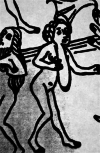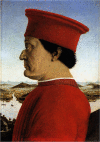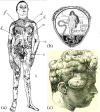Neurocutaneous syndromes in art and antiquities
- PMID: 34013593
- PMCID: PMC8252443
- DOI: 10.1002/ajmg.c.31917
Neurocutaneous syndromes in art and antiquities
Erratum in
-
Corrigendum Neurocutaneous syndromes in Art and Antiquities. Am J Med Genet C. 2021;187(2):224-234. Doi:10.1002/ajmg.c.31917.Am J Med Genet C Semin Med Genet. 2022 Sep;190(3):404. doi: 10.1002/ajmg.c.31961. Epub 2021 Dec 22. Am J Med Genet C Semin Med Genet. 2022. PMID: 34939310 Free PMC article. No abstract available.
Abstract
Neurocutaneous syndromes are a group of genetic disorders affecting the skin, the central and peripheral nervous system, and the eye with congenital abnormalities and/or tumors. Manifestations may also involve the heart, vessels, lungs, kidneys, endocrine glands and bones. When people with these disorders are portrayed in works of art, physicians have speculated on possible diagnoses. In particular, many figures have been labeled as possibly having a neurocutaneous disorder, sometimes distorting the popular conception of these diseases. We review numerous documents, drawings, prints, lithographs, xylographs, and portraits which span the ages from antiquity to the era of the pioneers behind the eponyms, depicting a large spectrum of neurocutaneous disorders.
Keywords: artwork; disorders; neurocutaneous; painting; phacomatosis; print.
© 2021 The Authors. American Journal of Medical Genetics Part C: Seminars in Medical Genetics published by Wiley Periodicals LLC.
Conflict of interest statement
None.
Figures








References
-
- Ahn, M. S. , Jackler, R. K. , & Lustig, L. R. (1996). The early history of the neurofibromatoses. Evolution of the concept of neurofibromatosis type 2. Archives of Otolaryngology ‐ Head & Neck Surgery, 122, 1240–1249. - PubMed
-
- Aldrovandi, U. (1642). Monstruorum Historia: Cum Paralipomenis Historiae omnium Animalium (p. 1642). Bologna: Typis Nocolai Tibaldini.
-
- Ashrafian, H. (2011). Limb gigantism, neurofibromatosis and royal heredity in the Ancient World 2500 years ago: Achaemenids and Parthians. Journal of Plastic, Reconstructive and Aesthetic Surgery, 64, 557. - PubMed
-
- Ashrafian, H. (2017). Leonardo da Vinci's Virgin of the Rocks: Perhaps the first depiction of congenital vascular malformation syndrome. Italian Journal of Anatomy and Embryology, 3, 155–156. 10.13128/IJAE-22974 - DOI
-
- Ashwal, S. (1990). The founders of child neurology. San Francisco, CA: Norman Publishing.
Publication types
MeSH terms
LinkOut - more resources
Full Text Sources
Other Literature Sources

